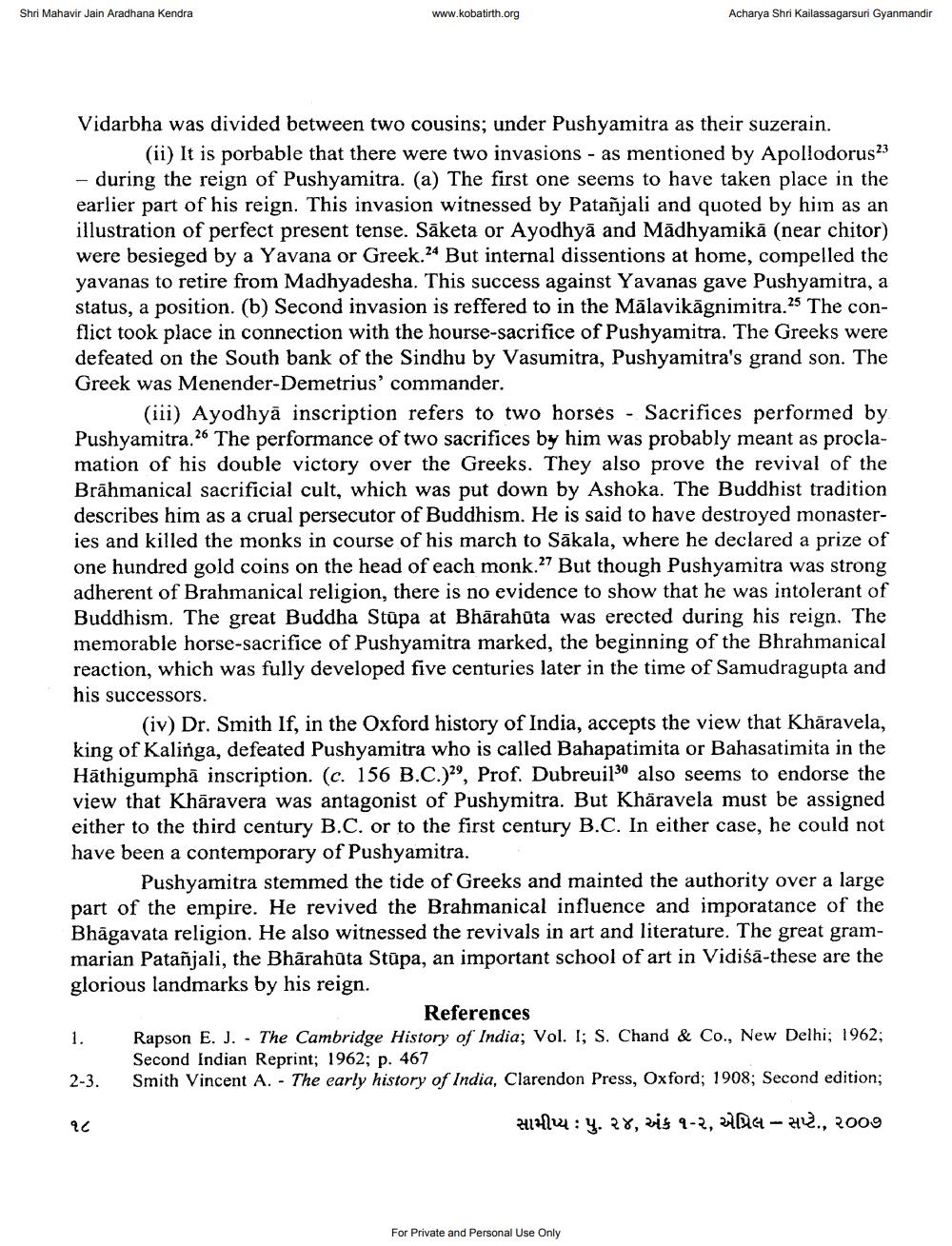________________
Shri Mahavir Jain Aradhana Kendra
www.kobatirth.org
Acharya Shri Kailassagarsuri Gyanmandir
Vidarbha was divided between two cousins; under Pushyamitra as their suzerain.
(ii) It is porbable that there were two invasions - as mentioned by Apollodorus23 - during the reign of Pushyamitra. (a) The first one seems to have taken place in the earlier part of his reign. This invasion witnessed by Patañjali and quoted by him as an illustration of perfect present tense. Sāketa or Ayodhyā and Mādhyamikā (near chitor) were besieged by a Yavana or Greek.24 But internal dissentions at home, compelled the yavanas to retire from Madhyadesha. This success against Yavanas gave Pushyamitra, a status, a position. (b) Second invasion is reffered to in the Mālavikāgnimitra.25 The conflict took place in connection with the hourse-sacrifice of Pushyamitra. The Greeks were defeated on the South bank of the Sindhu by Vasumitra, Pushyamitra's grand son. The Greek was Menender-Demetrius' commander.
(iii) Ayodhyā inscription refers to two horsés - Sacrifices performed by Pushyamitra.26 The performance of two sacrifices by him was probably meant as proclamation of his double victory over the Greeks. They also prove the revival of the Brāhmanical sacrificial cult, which was put down by Ashoka. The Buddhist tradition describes him as a crual persecutor of Buddhism. He is said to have destroyed monasteries and killed the monks in course of his march to Sākala, where he declared a prize of one hundred gold coins on the head of each monk.27 But though Pushyamitra was strong adherent of Brahmanical religion, there is no evidence to show that he was intolerant of Buddhism. The great Buddha Stupa at Bhārahuta was erected during his reign. The memorable horse-sacrifice of Pushyamitra marked, the beginning of the Bhrahmanical reaction, which was fully developed five centuries later in the time of Samudragupta and his successors.
(iv) Dr. Smith If, in the Oxford history of India, accepts the view that Khäravela, king of Kalinga, defeated Pushyamitra who is called Bahapatimita or Bahasatimita in the Häthigumphā inscription. (c. 156 B.C.)29, Prof. Dubreuil 30 also seems to endorse the view that Khāravera was antagonist of Pushymitra. But Khäravela must be assigned either to the third century B.C. or to the first century B.C. In either case, he could not have been a contemporary of Pushyamitra.
Pushyamitra stemmed the tide of Greeks and mainted the authority over a large part of the empire. He revived the Brahmanical influence and imporatance of the Bhāgavata religion. He also witnessed the revivals in art and literature. The great grammarian Patañjali, the Bhārahūta Stupa, an important school of art in Vidiśä-these are the glorious landmarks by his reign.
References 1. Rapson E. J. - The Cambridge History of India; Vol. I; S. Chand & Co., New Delhi; 1962;
Second Indian Reprint; 1962; p. 467 2-3. Smith Vincent A. - The early history of India, Clarendon Press, Oxford; 1908; Second edition;
اه
zual: . 28, zis 9-2, 104 - 2744., 2009
For Private and Personal Use Only




